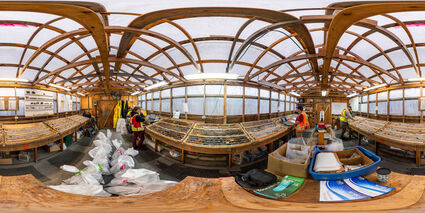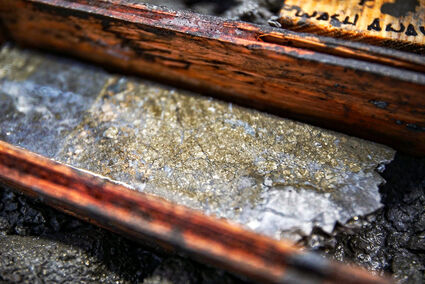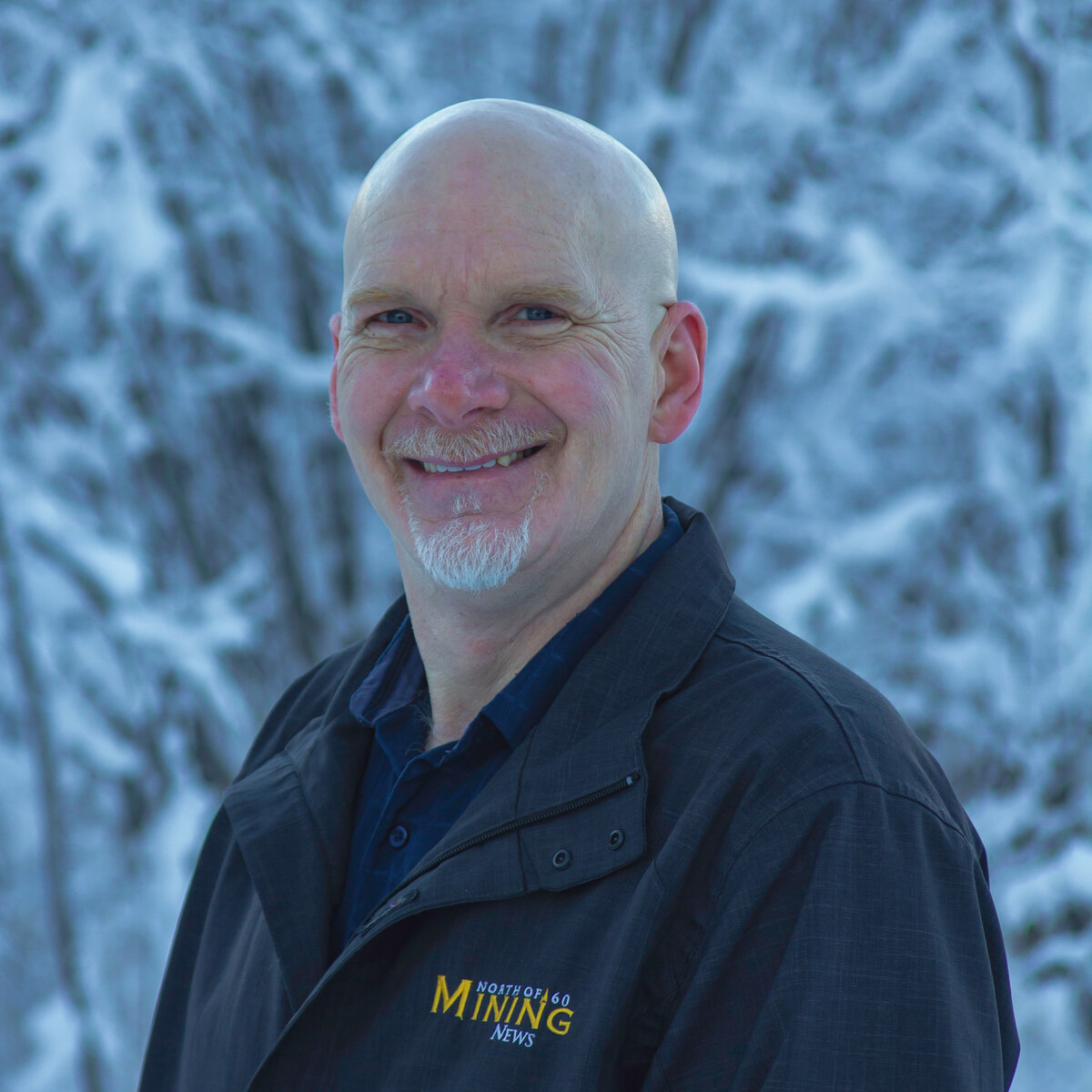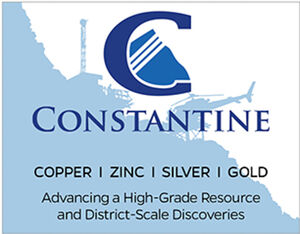Revisiting iconic Golden Triangle mines
Skeena rapidly advances mine at Eskay Creek, explores Snip Mining Explorers 2020 - Published January 19, 2021
Last updated 1/14/2021 at 2:55pm

Skeena Resources Ltd.
Skeena technicians logged core from 88,000 meters of resource upgrade, expansion, and exploration drilling completed at the Eskay Creek gold-silver mine project in British Columbia's Golden Triangle during 2020.
With robust support from the investment community, encouragement from Barrick Gold Corp., and a strong working relationship with the Tahltan First Nation, Skeena Resources Ltd. is rapidly advancing towards the reopening of Eskay Creek and Snip – iconic precious metals mines in the heart of British Columbia's Golden Triangle.
Both these high-grade gold and silver operations were previously operated by Barrick.
Over a 14-year span ending in 2008, an underground mine at Eskay Creek produced roughly 3.3 million ounces of gold and 160 million oz of silver at average grades of 45 grams per metric ton gold and 2,224 g/t silver, which at the time made it the world's highest-grade gold mine and fifth-largest silver mine by volume.
The historic underground mine at Snip produced 1.1 million ounces of gold from 1.25 million metric tons of ore averaging 27.5 g/t gold.
With strengthening precious metals prices, and more than C$2 billion invested in delivering industrial power and other infrastructure upgrades in British Columbia's Golden Triangle since the closure of Eskay Creek and Snip, Skeena cut deals with Barrick for these mines in 2017 and has been investing heavily into the drilling and other work to support a new generation of mining at this high-grade precious metals assets.
This work has primarily focused on exploring the potential of developing a mine at Eskay Creek, a high-grade volcanogenic massive sulfide deposit previously mined by Barrick.
In August, Barrick and Skeena entered into an agreement that transfers full ownership of Eskay Creek to Skeena.
In exchange, Barrick received 22.5 million Skeena units, which included one share of the junior plus half of a warrant that allows Barrick to acquire an additional Skeena share for C$2.70; and a 1% net smelter return (NSR) royalty on the entire Eskay Creek land package. Barrick also is entitled to a C$15 million contingent payment if Skeena sells more than a 50% interest in Eskay Creek over the next two years.
"The Skeena team has done a great job on its evaluation of Eskay Creek and this is another good example of a transaction that delivers a value creating opportunity for all stakeholders," said Barrick Gold President and CEO Mark Bristow.
Robust Eskay Creek PEA
Over the three years since optioning Eskay Creek, Skeena had built a near-surface resource that supported its ideas of developing an open-pit mine at this precious metal-rich VMS project previously mined from underground.
According to this calculation, Eskay Creek hosts 12.71 million metric tons of surface mineable indicated resource averaging 4.5 g/t (1.82 million oz) gold and 117 g/t (47.79 million oz) silver; plus 13.57 metric tons of surface mineable inferred resource averaging 2.2 g/t (984,000 oz) gold and 42 g/t (18.46 million oz) silver.
This resource formed the basis for a late-2019 preliminary economic assessment that outlined plans for a 6,850-metric-ton-per day operation at Eskay Creek that would produce an average of 236,000 oz of gold and 5.8 million oz of silver annually over an initial mine-life of 8.6 years.
At base case metals prices – US$1,325/oz gold and US$16/oz silver – this open-pit mine at Eskay Creek is calculated to produce an after-tax net present value (5% discount) of US$491 million and a very robust 51% internal rate of return.
At precious metals prices closer to the current environment – US$1,900/oz gold and US$23/oz silver –the after-tax NPV more than triples to US$1.5 billion and the IRR jumps to 89%.
Going with the base case scenario, it would take about 1.2 years to pay back the US$233 million in capital estimated to be needed to develop the mine. At the higher metals price scenario, this payback period drops to about eight months.
Given the robust economics outlined in the PEA, it is no wonder that investors clamored to participate in an early 2020 financing by Skeena, elevating the initial C$20 million offering to C$33.3 million by the time the oversubscribed private placement closed in April.
Skeena's treasury got a further boost in June when investors opted to acquire additional shares with the warrants they held.
"Skeena has spent almost C$25 million at Eskay Creek since we optioned the project from Barrick," Skeena Resources President and CEO Walter Coles said at the time. "Due to the exercise of warrants expiring last week, Skeena's cash position is approaching C$50 million. The company is fully funded for an exploration budget that will total approximately C$45 million for the balance of the year as we look to aggressively advance Eskay Creek."
This aggressive program includes carrying out the work needed to complete a prefeasibility study for Eskay Creek by mid-2021 and a feasibility study for the proposed open-pit mine by the end of the year.
Increasingly aggressive
With a full treasury and a goal of completing a feasibility study by the end of 2021, Skeena carried out roughly 88,000 meters of resource upgrade, expansion, and exploration drilling of Eskay during 2020.
Though this aggressive drill program was interrupted for nearly three months due to COVID-19, by October the company had completed a 26,000-meter initial phase at the iconic gold-silver mine project at the heart of BC's Golden Triangle.
The phase-one program included infill drilling to upgrade inferred resources to the higher confidence measured and indicated categories, as well as test expansion zones in proximity to the proposed open-pit.
Highlights from the phase-one drilling include:
• 22.1 meters averaging 3.62 g/t gold and 41 g/t silver in hole SK-20-259.
• 22.5 meters of 32.21 g/t gold and 121 g/t silver in SK-20-270.
• 24.6 meters of 5.9 g/t gold and 14 g/t silver in SK-20-271.
• 20 meters averaging 6.89 g/t gold and 10 g/t silver in hole SK-20-281.
• 35.4 meters averaging 21.9 g/t gold and 235 g/t silver in SK-20-290.
"In my experience, it is a rarity for a delineation drilling campaign on a precious metal deposit to consistently intersect the predicted mineralization defined by widely-spaced exploration drill holes," said Skeena Resources Vice President of Exploration and Resource Development Paul Geddes. "This success is not only a function of the Eskay Creek mineralization style, but also a result of the conservatively estimated MRE (mineral resource estimate)."
As other companies working in Northern British Columbia were winding down their 2020 season, Skeena was scaling up drilling at Eskay Creek.
In October, the company launched the second phase of the program, a 45,000-meter drill campaign that will have up to 11 drill rigs readying surface mineable resources at the iconic Northern British Columbia gold-silver mine property for a prefeasibility study slated for completion in 2021.
"The addition of five more drill rigs in the coming weeks should allow us to maintain our aggressive schedule to complete the phase-2 infill program before year end, as well as test certain high priority exploration targets," Coles said on Oct. 14.
Skeena is testing the exploration targets with a separate 17,000-meter program.
Snip headway
While Eskay Creek is the main focus for Skeena, the company continues to make headway at Snip, a historic underground mine about 35 kilometers (22 miles) west of Eskay Creek that produced 1.1 million oz of gold from 1.25 million metric tons of ore averaging 27.5 g/t gold.
According to a 2020 calculation, Snip hosts 539,000 metric tons of indicated resource averaging 14 g/t (244,000 oz) gold; and 942,000 metric tons of inferred resources averaging 13.3 g/t (402,000 oz) gold.
"We are very excited about the maiden resource at Snip, particularly because of the excellent grade and the proximity to Eskay Creek," said Skeena Resources President and CEO Walter Coles Jr. "We will commence drilling at Snip shortly to follow-up on the exciting exploration success from last summer in an effort to expand the resource."
Twin, the most prolific of the high-grade zones mined by Barrick, produced 709,601 oz of gold from ore that averaged 28.95 g/t gold.

Skeena Resources Ltd.
Core with high-grade gold-silver mineralization encountered at Skeena Resources' Eskay Creek project in Northern BC.
Skeena's 2019 drilling at Snip targeted an isolated high-grade intersection encountered by Barrick in 200 Footwall, a zone that has historically only been targeted with limited underground drilling.
One hole drilled in 1997, UG-2610, cut 3.4 meters of 26.83 g/t gold.
The best hole from Skeena's 2019 program at Snip, cut a 1.5-meter bonanza grade intercept averaging 1,131.9 g/t (36.39 oz/t) gold.
This high-grade zone will be among the targets Skeena follows up on when drilling resumes at Snip.
"Our efforts in the coming months will focus on expanding these now well-defined resources with expansion drilling in the newly evolving 200 Footwall Corridor as well as other near-mine targets," said Geddes.
Hochschild Mining PLC, London Stock Exchange, Hochschild operates four underground precious metals mines in Peru and Argentina, has the option to earn a 60% interest in Snip.


















Reader Comments(0)